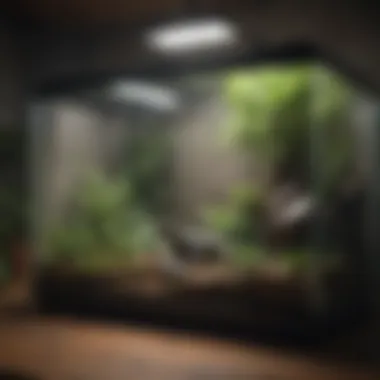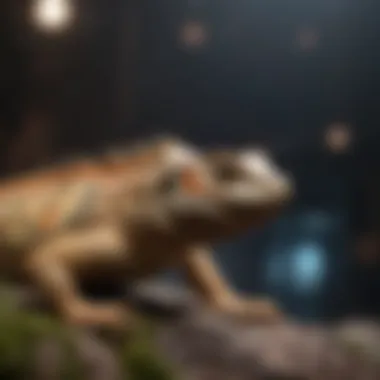Expert Tips for Setting Up a 20 Gallon Reptile Enclosure Like a Pro


Animal Species Profile
In the realm of reptiles, the 20-gallon cage offers a cozy haven for a variety of fascinating species. One such captivating creature often housed in these enclosures is the Leopard Gecko. Renowned for their unique appearance and docile nature, Leopard Geckos are one of the most popular reptile pets in the world. These reptiles exhibit distinct physical characteristics, including their iconic spotted patterns and elongated tails. With origins in the arid regions of Afghanistan, Pakistan, and India, Leopard Geckos have adapted to thrive in desert landscapes. Their behavior is characterized by nocturnal tendencies, burrowing habits, and solitary lifestyles, making them an intriguing species to observe in a confined habitat.
Physical Characteristics and Appearance
Leopard Geckos boast a mesmerizing appearance marked by their distinctive spots or "leopard-like" patterns, which provide excellent camouflage in their natural habitat. They typically range in size from 7 to 10 inches in length, showcasing vibrant hues of yellow, orange, and white. Known for their ability to shed their skin, these geckos sport impressive regenerative capabilities, shedding skin in pieces rather than a single molt. With their small claws and keen eyesight, Leopard Geckos are adept at climbing, hunting, and navigating their surroundings with precision.
Natural Habitat and Distribution
In the wild, Leopard Geckos inhabit arid and semi-desert regions of Central Asia, favoring rocky terrain and dry environments. These reptiles seek out shelter in burrows, cracks, or crevices during the scorching heat of the day, emerging at dusk to forage for insects and small invertebrates. Their distribution spans across rocky outcrops, sand dunes, and sparse vegetation, where they showcase remarkable adaptability to survive in harsh conditions through behavioral and physiological adjustments.
Behavior and Social Interactions
Leopard Geckos exhibit solitary behavior, only coming together during the breeding season. They are relatively docile towards humans but may display territorial instincts towards other geckos, especially during encounters over resources or mating partners. Communication among these reptiles primarily involves visual cues, body postures, and vocalizations, though they are not as vocal as some other reptilian species. Observing their interactions can provide insights into their territorial boundaries, breeding rituals, and territorial display, offering a glimpse into the intricate social dynamics within a Leopard Gecko population.
Introduction
When embarking on the journey of creating a suitable abode for your reptilian companion, one cannot underestimate the significance embodied in the initial steps of setting up a 20-gallon reptile cage. This phase marks the foundation upon which the well-being and contentment of your scaly friend will thrive. Understanding the intricacies and necessities at this juncture paves the way for a harmonious coexistence between human and reptile. Not merely a physical space but a sanctuary crafted with care and precision, the 20-gallon reptile cage speaks volumes about the dedication of a conscientious pet owner to ensure the comfort and vitality of their exotic pet. By comprehending the essence of this preliminary stage, one can establish a haven that not only meets but exceeds the requirements of their reptilian companion, fostering a bond built on trust and mutual respect.
Importance of a Suitable Enclosure


Turning our focus to the specific aspect of the importance of a suitable enclosure, we delve into the fundamental rationale behind selecting a habitat that caters to the distinct needs of reptiles. A suitable enclosure serves as more than just a physical containment; it acts as a mimicry of their natural habitat, offering a sense of security and stimulation essential for their well-being. The enclosure functions as a protective barrier against external threats, creating a controlled environment that regulates temperature, humidity, and lighting to mirror the conditions favorable to reptilian inhabitants. Optimal enclosure plays a pivotal role in maintaining physical health, psychological well-being, and behavioral balance, all of which are indispensable components of a thriving reptilian pet.
Overview of a Gallon Reptile Cage
Into the specifics of a 20-gallon reptile cage, we uncover the dimensions, features, and requisite elements that compose this dedicated space for your scaly companion. A 20-gallon cage offers a significant area for customized habitat creation, enabling pet owners to design a diverse landscape that caters to their reptile's species-specific requirements. This size strikes a balance between spaciousness and practicality, providing ample room for movement and enrichment while fitting comfortably within most living spaces. Understanding the layout and possibilities within a 20-gallon cage sets the stage for an immersive pet ownership experience, where interactions are curated through environmental design that both challenges and nurtures the reptilian occupant.
Key Considerations Before Setting Up
Prior to delving into the intricate details of setting up a 20-gallon reptile cage, it is imperative to address key considerations that will influence the design and maintenance of this specialized habitat. Factors such as the species of reptile, environmental requirements, behavioral patterns, and future growth expectations play a crucial role in shaping the initial setup decisions. Anticipating the long-term needs of the reptile, understanding the implications of habitat choices, and aligning them with the pet owner's lifestyle are paramount in creating a sustainable and enriching living space for the scaly companion. By comprehensively evaluating these considerations, pet owners can lay a strong foundation for a dynamic and evolving reptile enclosure that adapts to the changing needs and preferences of its inhabitant.
Choosing the Right Cage
When embarking on the journey of setting up a suitable habitat for your reptilian companion, the selection of the right cage plays a pivotal role in ensuring their well-being. In this section, we delve deep into the importance of choosing the right cage for your reptile within the context of our comprehensive guide. The cage serves as the primary foundation for creating an environment that caters to your pet's natural behaviors, comfort, and security. By focusing on specific elements such as material, size, and design, you can provide a safe and enriching space that mirrors their natural habitat.
Material and Construction
Glass Enclosures
Glass enclosures stand out as a popular choice among reptile enthusiasts due to their excellent visibility and sleek aesthetics. They offer a transparent view into your pet's world, allowing you to observe their behavior closely. The transparency of glass aids in simulating a more natural environment for your reptile, promoting well-being and reducing stress. However, glass enclosures may be heavier than other options and can be prone to breakage if mishandled.
Plastic Tanks


Plastic tanks have gained popularity for their lightweight construction and versatility. They are easily customizable, making them an ideal choice for creating custom habitats according to your reptile's needs. Plastic tanks are durable and can withstand various environments, making them suitable for different reptile species. Despite their benefits, some plastic tanks may not provide as much thermal insulation as other materials.
Wooden Vivariums
Wooden vivariums offer a natural and aesthetically pleasing housing option for your reptile. The wooden construction provides excellent insulation properties, helping to maintain optimal temperatures within the enclosure. These cages replicate a more natural habitat, promoting a sense of security and comfort for your pet. However, wooden vivariums may require additional sealing to prevent moisture damage and rot over time.
Setting Up the Interior
In this crucial section of our guide on setting up a 20-gallon reptile cage, we delve into the intricacies of creating a habitat that promotes both the physical and mental well-being of your scaly companion. Setting up the interior of the enclosure is not just about aesthetics but plays a vital role in mimicking the natural environment of reptiles. This aspect is essential in providing them with a sense of security and comfort, ultimately leading to a happier and healthier pet.
When it comes to setting up the interior, one of the most critical elements to consider is the substrate. The substrate, which is the material covering the floor of the enclosure, serves various purposes such as providing a comfortable surface for your reptile to walk on, aiding in maintaining humidity levels, and facilitating natural behaviors like burrowing. Selecting the right substrate is crucial as it can impact your pet's overall well-being. Factors to consider include the substrate's ability to retain moisture, ease of cleaning, and whether it is non-toxic to your reptile.
Apart from the substrate, another key consideration in setting up the interior of the enclosure is ensuring adequate temperature and lighting. Reptiles are ectothermic creatures, meaning they rely on external heat sources to regulate their body temperature. Providing a suitable heat gradient across the enclosure is vital to allow your pet to thermoregulate effectively. Additionally, proper lighting, including both UVB and UVA light, is essential for your reptile's overall health, as it aids in calcium metabolism and vitamin D synthesis.
In creating an enriching environment for your reptile, incorporating hiding spots and enrichment items is crucial. Hiding spots offer your pet a place to retreat and feel secure, reducing stress levels. These hiding spots can range from naturalistic shelters to commercially available hides. Enrichment items such as climbing branches, rocks, and toys provide mental stimulation and physical exercise for your reptile, promoting overall well-being and preventing boredom. By carefully considering these aspects in the interior setup, you can ensure a comfortable and stimulating environment for your scaly companion.
Maintaining the Habitat
Maintaining the habitat is a crucial aspect of ensuring the well-being and longevity of your reptilian companion. In this comprehensive section, we will delve into the vital practices and considerations required to upkeep a healthy environment within the 20-gallon reptile cage. Proper maintenance not only contributes to the physical health of the inhabitant but also fosters a stress-free and comfortable space that mimics their natural habitat.
Cleaning and Hygiene Practices ( words)


A clean enclosure is paramount for the health and happiness of your reptile. Regular cleaning routines help prevent the build-up of harmful bacteria and ensure a hygienic living space. To maintain cleanliness, remove feces, shed skin, and uneaten food promptly. In addition, disinfect the enclosure periodically using reptile-safe cleaning agents to eradicate germs and parasites effectively. Remember to scrub surfaces, replace substrate regularly, and sterilize any accessories to prevent contamination. By prioritizing hygiene practices, you actively contribute to your pet's overall well-being.
Regular Monitoring and Adjustments ( words)
Consistent monitoring of environmental conditions is essential for creating a comfortable habitat for your reptile. Regularly check temperature and humidity levels using reliable gauges to ensure they are within the optimal range for your pet's species. Make adjustments as needed, such as adding or adjusting heating or lighting sources to maintain a stable microclimate. Monitor your reptile's behavior and appetite as indicators of their health and comfort. By staying attentive and proactive, you can address any issues promptly and create a safe and nurturing environment.
Diet and Nutrition Guidelines ( words)
Providing a balanced and nutritious diet is paramount for the overall health and vitality of your reptile. Research the specific dietary requirements of your pet's species and offer a varied diet that includes live insects, leafy greens, fruits, and appropriate supplements. Consider consulting a reptile veterinarian or specialist to tailor a diet plan that meets your pet's individual needs. Ensure fresh water is always available, and monitor your pet's feeding habits to assess their nutritional intake. By adhering to proper diet and nutrition guidelines, you actively contribute to your reptile's well-being and promote a thriving captive environment.
Ensuring Safety and Security
In the realm of reptile husbandry, ensuring safety and security within the habitat is paramount. The meticulous oversight of safety measures not only safeguards your scaly companion but also creates a conducive environment for their well-being. Investing in the security of the reptile enclosure is akin to fortifying a castle to protect its valuable occupants. To overlook safety precautions is to invite potential risks and hazards that could compromise the health and longevity of your reptile pet. Hence, comprehensive safety and security protocols are indispensable components of responsible reptile care.
Escape-Proofing Measures
When considering escape-proofing measures for your reptile's habitat, attention to detail is crucial. Escape incidents can pose significant dangers to both the reptile and its surroundings, leading to stress, injury, or the destruction of property. Ensuring secure locking mechanisms on enclosures, covering gaps or openings that may serve as escape routes, and routinely inspecting for any weaknesses in the containment structure are essential steps in preventing potential escapes. Incorporating locks, specially designed closures, and sturdy materials can significantly reduce the risks of unauthorized wanderings by your reptilian companion.
Toxicity Awareness
Toxicity awareness is a critical aspect of reptile care that should not be underestimated. Reptiles, with their inquisitive nature, may interact with various elements within their habitat that could be potentially harmful. Understanding the toxicity levels of plants, substrate materials, or any other items present in the enclosure is vital for ensuring the well-being of your reptile. Regularly researching and monitoring the toxicity of common household items or plants to which your reptile may be exposed is a proactive measure in preventing accidental poisonings. By staying informed and attentive to potential toxic hazards, you can create a safer and more secure environment for your reptilian companion.
Conclusion
The conclusion of this guide to setting up a 20-gallon reptile cage encapsulates the essence and significance of meticulous habitat planning for reptilian companions. By understanding the various components discussed in the preceding sections, one can truly appreciate the nuanced art of creating a habitat that not only meets the physical needs of the reptile but also nurtures its overall well-being. The conclusion serves as a synthesis of all the insights provided, offering a holistic view of the essential aspects required for an optimal reptile environment.
When contemplating the complexity of reptile care, the conclusion stands as a crucial compass, guiding enthusiasts towards a successful and enriching journey with their scaly pets. It not only summarizes the key takeaways but also instills a sense of responsibility in the pet owner to ensure the habitat is not just a physical space but a sanctuary that promotes the reptile's natural behaviors and physiological requirements. Emphasizing the importance of balance, the conclusion underscores the need for continual monitoring, adjustment, and dedication to creating a harmonious living space for the reptile.
By delving deep into the nuances of habitat setup and maintenance, the conclusion wraps up the guide with a call to action for pet owners to prioritize the well-being of their reptilian companions. It reinforces the notion that setting up a 20-gallon reptile cage is not merely a task but a journey that requires diligent effort, passion, and a profound understanding of the reptile's unique needs and preferences. Ultimately, the conclusion serves as a testament to the bond between human caretakers and their reptilian friends, highlighting the mutual growth and enrichment derived from cultivating a conducive habitat.







